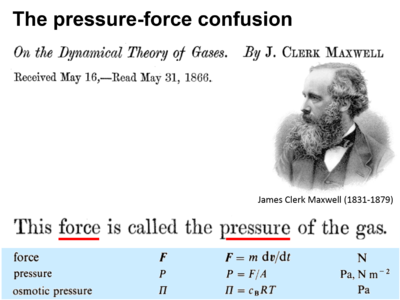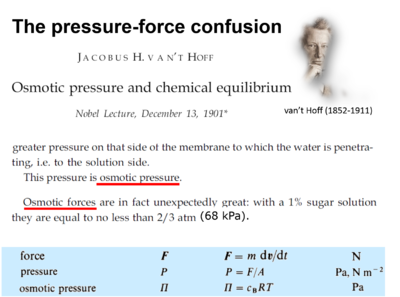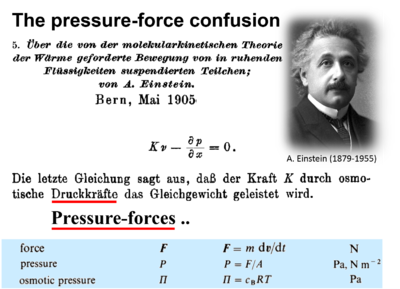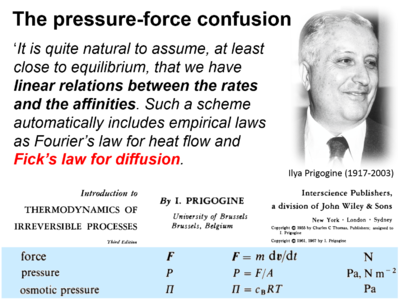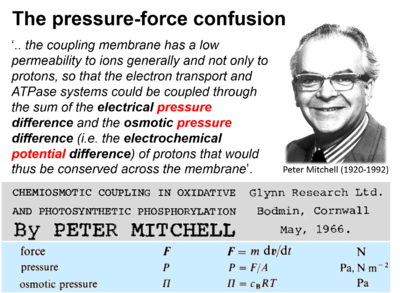Pressure: Difference between revisions
No edit summary |
No edit summary |
||
| Line 1: | Line 1: | ||
{{MitoPedia | {{MitoPedia | ||
|abbr=''P'', ''p'', ''Π'' [Pa] | |abbr=''P'', ''p'', ''Π'' [Pa] | ||
|description='''Pressure''' [Pa = J·m<sup>-3</sup>] is the concentration of the [[force]] at the point of [[action]]. More generally, pressure is the force times concentration at the interphase of interaction. | |description='''Pressure''' is a fundamental quantity expressing energy per volume. The unit of pressure is always [Pa] = [J·m<sup>-3</sup>]. Pressure is known in physics as mechanical pressure, which is force per area, ''p'' = ''F''·''A''<sup>-1</sup> [N·m<sup>-2</sup>]. In physical chemistry, gas pressure is defined as ''p'' = ''n''·''V''<sup>-1</sup>·''RT'', where the [[concentration]] is ''c'' = ''n''·''V''<sup>-1</sup>, ''R'' is the [[gas constant]], and ''T'' is the absolute temperature. van't Hoff's osmotic pressure assumes the same form applied to dissolved substances diffusing across a semipermeable membrane, but concentrations should be replaced by [[activity |activities]]. The activity of dissolved gases is expressed by the [[partial pressure]], where the [[solubility]] can be seen as an activity coefficient. Pressure appears explicitely or implicitely in all chapters of physics and physical chemistry. But in contrast to the universal counterparts energy and force, the general connections between various isomorphic expressions of pressure remain poorly understood: Pressure is the concentration of the [[force]] at the point of [[action]]. More generally, pressure is the force times concentration at the interphase of interaction. | ||
|info=[[Gnaiger 1989 Energy Transformations]]; [[Gnaiger 2017 MiP2017]] | |||
}} | |||
Communicated by [[Gnaiger E |Erich Gnaiger]] 2018-09-16 (last update 2020-02-15) | |||
::::::::::::::::* The prevailing hypothesis of light at the time was that of Descartes. He believed that light was a 'pressure' transmitted through the transparent medium of the ether. Sight, he claimed, was due to this pressure impinging upon the optic nerve. - (White 1997: p 58-59) | |||
::::::::::::::::* In both the "Hypothesis" of 1675 and the student notebook of 1661-65, Newton tended to attribute gravity to the pressure of a descending aetherial shower. - (Dobbs 1975: p 210) | |||
In the classical physicochemical literature, there is confusion between the terms force and pressure: ''"This force is called the pressure of the gas"'' by [[Maxwell 1867 Phil Trans Royal Soc London |Maxwell (1867)]] | == Isomorphic laws and isomorphic formats == | ||
:::: In physical chemistry, gas pressure is defined by the fundamental Gas law, which can be expressed in different isomorphic formats, as ''p'' = ''C''·''kT'' (product of particle concentration [x·m<sup>-3</sup>] times ''kT'' [J·x<sup>-1</sup>]) or ''p'' = ''c''·''RT'' (amount of substance concentration [mol·m<sup>-3</sup>] times ''RT'' [J·mol<sup>-1</sup>]), where ''k'' is the [[Boltzmann constant]], ''R'' is the [[gas constant]], ''T'' is the absolute temperature. | |||
:::: In addition to mechanical and gas pressure (hydrostatic pressure, barometric pressure, gas pressure), isomorphic pressures are distinguished as [[osmotic pressure]], [[diffusion pressure]], [[reaction pressure]], and [[electric pressure]]. | |||
:::: In [[ergodynamics]], the pressure in a transformation, Δ<sub>tr</sub>''Π'', is the product of [[free activity]] times [[force]], Δ<sub>tr</sub>''Π'' = ''α''<sub>tr</sub>·Δ<sub>tr</sub>''F'' [mol·m<sup>-3</sup> · J·mol<sup>-1</sup> = J·m<sup>-3</sup> = Pa] ([[Gnaiger 1989 Energy Transformations]] Gnaiger 1989). | |||
== Thje pressure-force confusion == | |||
:::: In the classical physicochemical literature, there is confusion between the terms force and pressure: | |||
::::* ''"This force is called the pressure of the gas"'' by [[Maxwell 1867 Phil Trans Royal Soc London |Maxwell (1867)]]. | |||
::::* ''"This pressure is osmotic pressure. .. Osmotic forces are in fact .."'' by [[Van't Hoff 1901 Nobel Lecture |van't Hoff 1901]]. | |||
::::* ''"Pressure-forces"'' by [[Einstein 1905 Ann Physik 549 |Einstein (1905)]]. | |||
::::* Presentation of ''Fick's law of diffusion'' (which represents a flux-pressure relationship) as a flux-force relationship by [[Prigogine 1967 Interscience |Prigogine (1967)]]. | |||
<gallery mode=default perrow=2 widths="400px" heights="300px"> | <gallery mode=default perrow=2 widths="400px" heights="300px"> | ||
| Line 23: | Line 34: | ||
</gallery> | </gallery> | ||
{{Keywords: Concentration and pressure}} | |||
== References == | == References == | ||
::::* Dobbs BJT (1975) The foundations of Newton's alchemy or "The hunting of the Greene Lyon". Reissued as a paperback 1983. Cambridge Univ Press Cambridge:300 pp. - [[Dobbs 1975 Cambridge Univ Press | »Bioblast link«]] | ::::* Dobbs BJT (1975) The foundations of Newton's alchemy or "The hunting of the Greene Lyon". Reissued as a paperback 1983. Cambridge Univ Press Cambridge:300 pp. - [[Dobbs 1975 Cambridge Univ Press | »Bioblast link«]] | ||
| Line 36: | Line 48: | ||
|mitopedia concept=MiP concept, Ergodynamics | |mitopedia concept=MiP concept, Ergodynamics | ||
}} | }} | ||
Revision as of 12:54, 16 February 2020
Description
Pressure is a fundamental quantity expressing energy per volume. The unit of pressure is always [Pa] = [J·m-3]. Pressure is known in physics as mechanical pressure, which is force per area, p = F·A-1 [N·m-2]. In physical chemistry, gas pressure is defined as p = n·V-1·RT, where the concentration is c = n·V-1, R is the gas constant, and T is the absolute temperature. van't Hoff's osmotic pressure assumes the same form applied to dissolved substances diffusing across a semipermeable membrane, but concentrations should be replaced by activities. The activity of dissolved gases is expressed by the partial pressure, where the solubility can be seen as an activity coefficient. Pressure appears explicitely or implicitely in all chapters of physics and physical chemistry. But in contrast to the universal counterparts energy and force, the general connections between various isomorphic expressions of pressure remain poorly understood: Pressure is the concentration of the force at the point of action. More generally, pressure is the force times concentration at the interphase of interaction.
Abbreviation: P, p, Π [Pa]
Reference: Gnaiger 1989 Energy Transformations; Gnaiger 2017 MiP2017
Communicated by Erich Gnaiger 2018-09-16 (last update 2020-02-15)
- The prevailing hypothesis of light at the time was that of Descartes. He believed that light was a 'pressure' transmitted through the transparent medium of the ether. Sight, he claimed, was due to this pressure impinging upon the optic nerve. - (White 1997: p 58-59)
- In both the "Hypothesis" of 1675 and the student notebook of 1661-65, Newton tended to attribute gravity to the pressure of a descending aetherial shower. - (Dobbs 1975: p 210)
Isomorphic laws and isomorphic formats
- In physical chemistry, gas pressure is defined by the fundamental Gas law, which can be expressed in different isomorphic formats, as p = C·kT (product of particle concentration [x·m-3] times kT [J·x-1]) or p = c·RT (amount of substance concentration [mol·m-3] times RT [J·mol-1]), where k is the Boltzmann constant, R is the gas constant, T is the absolute temperature.
- In addition to mechanical and gas pressure (hydrostatic pressure, barometric pressure, gas pressure), isomorphic pressures are distinguished as osmotic pressure, diffusion pressure, reaction pressure, and electric pressure.
- In ergodynamics, the pressure in a transformation, ΔtrΠ, is the product of free activity times force, ΔtrΠ = αtr·ΔtrF [mol·m-3 · J·mol-1 = J·m-3 = Pa] (Gnaiger 1989 Energy Transformations Gnaiger 1989).
Thje pressure-force confusion
- In the classical physicochemical literature, there is confusion between the terms force and pressure:
- "This force is called the pressure of the gas" by Maxwell (1867).
- "This pressure is osmotic pressure. .. Osmotic forces are in fact .." by van't Hoff 1901.
- "Pressure-forces" by Einstein (1905).
- Presentation of Fick's law of diffusion (which represents a flux-pressure relationship) as a flux-force relationship by Prigogine (1967).
- In the classical physicochemical literature, there is confusion between the terms force and pressure:
- Bioblast links: Concentration and pressure - >>>>>>> - Click on [Expand] or [Collapse] - >>>>>>>
- Concentration
- » Volume
- » Activity
- » Concentration
- » Density
- » Mole
- » Molar mass
- Concentration
- Pressure
- Solubility = concentration/pressure
- General
- » Boltzmann constant
- » Energy
- » Force
- » Gas constant
- » Work
- General
- Related keyword lists
References
- Dobbs BJT (1975) The foundations of Newton's alchemy or "The hunting of the Greene Lyon". Reissued as a paperback 1983. Cambridge Univ Press Cambridge:300 pp. - »Bioblast link«
- White M (1997) Isaak Newton. The last sorcerer. Fourth Estate, London 402 pp. - »Bioblast link«
- Maxwell JC ( 1867) On the dynamical theory of gases. Phil Trans Royal Soc London 157:49-88. - »Bioblast link«
- van't Hoff JH (1901) Osmotic pressure and chemical equilibrium. Nobel Lecture December 13, 1901. - »Bioblast link«
- Einstein A (1905) Über die von der molekularkinetischen Theorie der Wärme geforderte Bewegung von in ruhenden Flüssigkeiten suspendierten Teilchen. Ann Physik 4, XVII:549-60. - »Bioblast link«
- Prigogine I (1967) Introduction to thermodynamics of irreversible processes. Interscience New York, 3rd ed:147pp. - »Bioblast link«
- Mitchell P (1966) Chemiosmotic coupling in oxidative and photosynthetic phosphorylation. Biochim Biophys Acta Bioenergetics 1807 (2011):1507-38. - »Bioblast link«
- Gnaiger E (1989) Mitochondrial respiratory control: energetics, kinetics and efficiency. In: Energy transformations in cells and organisms. Wieser W, Gnaiger E (eds), Thieme, Stuttgart:6-17. - »Bioblast link: introducing chemical reaction pressure«
MitoPedia concepts:
MiP concept,
Ergodynamics

